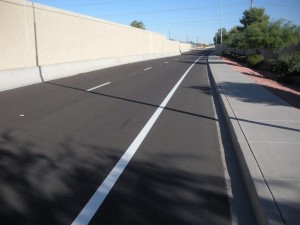Undesignated Bike lanes

Question
Ed asked: I found this on http://www.floridabicycle.org/rules/bikelaw.html :
Paved shoulders — Where a curb is not present, the right-hand edge of a roadway is the line between the roadway and the shoulder. Since the definition of “roadway” excludes the shoulder [§316.003], cyclists are not required to ride on paved shoulders, although they may prefer to do so.
What about if both a curb AND an edge line (but not a designated bike lane) are present? e.g. as pictured here:
http://blog.cazbike.org/2010/11/pricehwy-101-frontage-roads-edge-lines.html
(Or don’t you do that in Florida?)
Answer
We used to do that here, but the new FDOT guidance eliminated such striping except when marked as a bike lane. Please see:


If your state abides by or uses the Manual on Uniform Traffic Control Devices, the answer is in section 3B.06
“Edge Line Pavement Markings Standard:
If used, edge line pavement markings shall delineate the right or left edges of a roadway.
Except for dotted edge line extensions…”
If your state abides by or uses the Manual on Uniform Traffic Control Devices, the answer is in section 3B.06
“Edge Line Pavement Markings Standard:
If used, edge line pavement markings shall delineate the right or left edges of a roadway.
Except for dotted edge line extensions…”
All white lines are not necessarily edge lines. In the absence of a curb, an edge line delineates the roadway edge. The roadway is determined by state statute.
s. 316.003 – Definitions
(42) Roadway – That portion of a highway improved, designed, or ordinarily used for vehicular travel, exclusive of the berm or shoulder.
We need to be careful of the definitions and their source. For example, the Florida Department of Transportation defines the roadway as including the paved shoulder, whereas the statutes do not.
“We need to be careful of the definitions and their source. For example, the Florida Department of Transportation defines the roadway as including the paved shoulder, whereas the statutes do not.”
—————-
Note that I wrote, “if your state abides by or uses the Manual on Uniform Traffic Control Devices”. I know that in my state, there is no statute defining where the shoulder starts or what defines a shoulder. Florida’s statutes seem similarly ambiguous. My state does recognizes the authority of the MUTCD in the statutes so those definitions are as far as I know legally binding.
As far as the white line in the picture it sure doesn’t look like a lane line or any other white line marking listed in the MUTCD. I don’t know if Florida recognizes the MUTCD, but that sure appears to be a white edge line to me.
Of course I’m not a lawyer and I don’t play one on TV, so take everything here with that grain of salt.
In the above picture, I would ride on that as if it was a bike lane (marked or not).
There are millions of roads in Florida that do NOT have a bike lane description on them or on signs, and I seriously doubt anyone would care if a bicyclist used that area as a bike lane.
“but the new FDOT guidance eliminated such striping except when marked as a bike lane. Please see:”
The new rule appears to have been published in 05/2010, but a state highway in Orlando, Mills Ave. (US 17-92), was re-striped in September with those stripes. The “lane” is about 5 feet wide.
I have forwarded your comment to some knowledgeable folks in Orlando for their input.
Florida has been striping such “undesignated bike lanes” for about 20 years. Until recently, “undesignated bike lanes” were noted and permitted in the FDOT Plans Preparation Manual. They no longer allow for “undesignated” bike lanes; they must be designated. But since such lanes were allowed in the past, they should be grandfathered in. But they also will be designated during the next resurfacing/restriping.
The question is not whether a cyclist may use such a space; they clearly can. It’s whether or not they are required to use it. The new version of 316.2065(5) says cyclists must use a “lane marked for bicycle use.” But it also says cyclists must travel as close as practicable to the roadway edge. It’s not the stripe that makes the use mandatory (since it’s not marked for bicycle use), but whether or not the use of that space is practicable.
Cycling two-abreast is generally permitted unless doing so impedes traffic. With such an undesignated space, it’s not practicable to ride too far right, since the left side cyclists would get squeezed by passing motor vehicles. Controlling the general use lane is safer. But if the lane is designated, then cycling two-abreast is essentially made illegal, since there is no exception given for traveling two-abreast.
“Must use”….
IF they are on the roadway.
“(5)(a)Any person operating a bicycle upon a roadway at less than the normal speed of traffic at the time and place and under the conditions then existing shall ride in the lane marked for bicycle use….”
Doesn’t mean you can’t use a sidewalk to ride even if there is a bike lane.
The reason that is, is because the sidewalk is NOT part of the roadway..